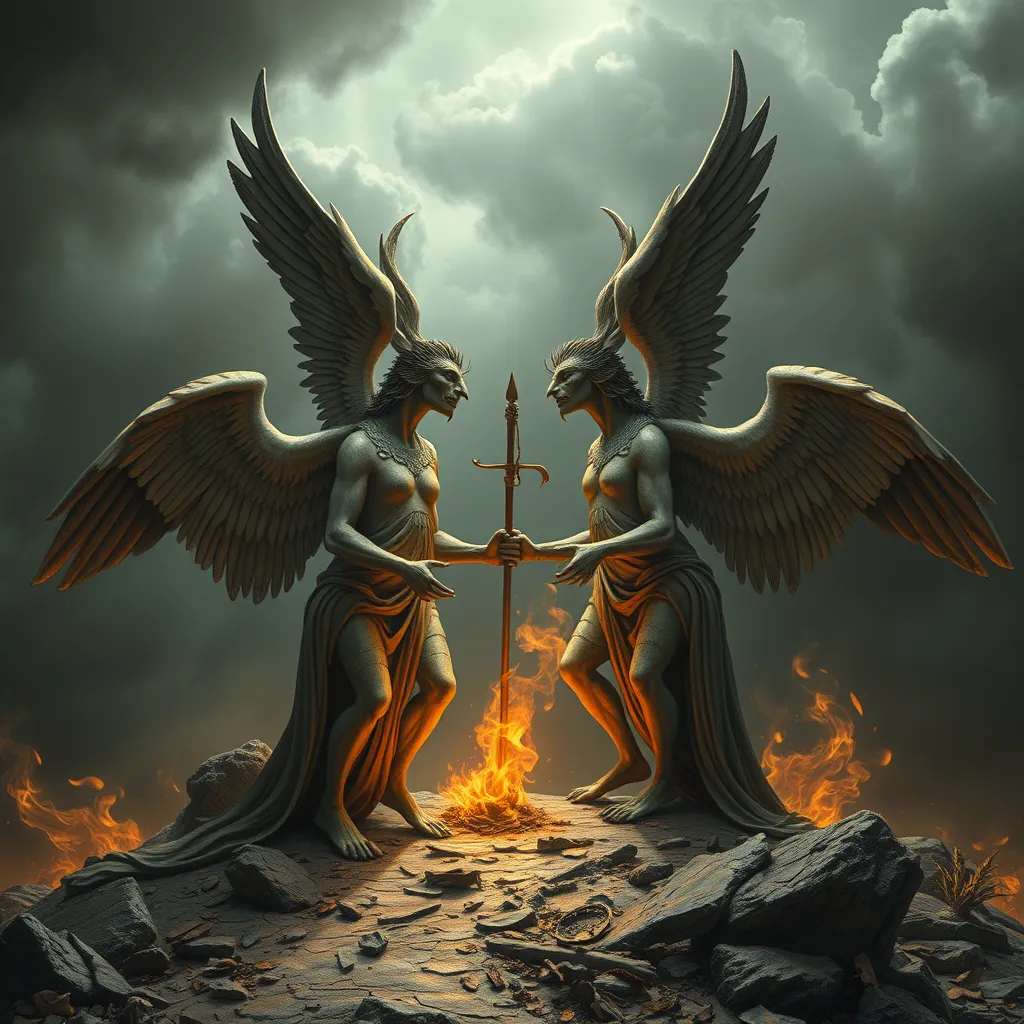The Hecatoncheires and the Search for Meaning: Exploring the Power of Myth
I. Introduction
The Hecatoncheires, often referred to as the “Hundred-Handed Ones,” are fascinating figures from Greek mythology. They embody extraordinary physical power and complexity, representing a unique aspect of the mythological landscape. Myths like that of the Hecatoncheires provide profound insights into the human experience, exploring themes of chaos, order, and the eternal quest for meaning in life.
This article aims to delve into the origins, symbolism, and psychological interpretations of the Hecatoncheires, as well as their relevance in modern society. By examining these themes, we can better understand the enduring power of myth and its significance in our search for meaning.
II. The Origin of the Hecatoncheires in Greek Mythology
The Hecatoncheires, named Briareus, Aegaeon, and Cottus, were born from the primordial beings Gaia (Earth) and Uranus (Sky). They are described as having one hundred hands and fifty heads, a striking image that symbolizes their immense strength and formidable presence in the mythological narrative.
According to myth, the Hecatoncheires played a crucial role during the Titanomachy, the legendary battle between the Titans and the Olympian gods. Initially imprisoned by their father Uranus, they were later freed by Zeus, who recognized their potential as powerful allies. Their involvement in the battle proved decisive, showcasing their ability to wield chaotic power in the service of order.
III. Symbolism and Representation in Myth
The Hecatoncheires serve as potent symbols of both chaos and order in mythology. Their many hands represent the chaotic forces of nature and the universe, while their unified purpose aligns them with the order established by the Olympian gods.
- Chaos and Order: The Hecatoncheires illustrate the tension between these two forces. Their chaotic nature, with multiple limbs and heads, signifies the unpredictability of life, while their alignment with Zeus represents the triumph of order over chaos.
- Multiplicity: The physical attributes of the Hecatoncheires—a hundred hands and fifty heads—can be interpreted as a metaphor for the complexity of existence. They embody the idea that life can be overwhelming, but through unity and cooperation, we can navigate its challenges.
- Power and Vulnerability: While they possess immense strength, the Hecatoncheires also reflect vulnerability. Their dependence on Zeus for liberation highlights the delicate balance between power and submission.
IV. The Hecatoncheires and the Human Condition
The narrative of the Hecatoncheires resonates deeply with the human experience, particularly in our quest for meaning amidst overwhelming forces. In many ways, they mirror our struggles with external pressures and the search for identity.
- Overwhelming Forces: Just as the Hecatoncheires faced the might of the Titans, individuals often confront societal expectations, personal struggles, and existential dilemmas. The story encourages resilience in the face of adversity.
- Multiple Identities: The Hecatoncheires embody the idea of possessing multiple identities and perspectives. Their many heads symbolize the various roles we play in life, reflecting the complexity of our identities.
- Finding Meaning: The quest for meaning is a universal theme. The Hecatoncheires’ journey from imprisonment to liberation signifies the potential for personal growth and understanding through adversity.
V. The Hecatoncheires in Literature and Popular Culture
The influence of the Hecatoncheires extends beyond ancient texts, permeating literature and popular culture. They appear in various forms, often representing chaos or the duality of power.
- Classical Texts: References to the Hecatoncheires can be found in works such as Hesiod’s “Theogony,” where their role in the Titanomachy is detailed.
- Modern Literature: Contemporary authors often draw inspiration from the Hecatoncheires to explore themes of identity and conflict. For example, their portrayal in fantasy novels frequently reflects struggles against oppressive forces.
- Films and Art: The Hecatoncheires have inspired various film adaptations and artistic representations, where they symbolize the battle between chaos and order in visual storytelling.
VI. The Psychological Interpretation of the Hecatoncheires
From a psychological perspective, the Hecatoncheires can be analyzed through Jungian archetypes and the concept of the collective unconscious. They serve as a metaphor for internal conflict and the integration of various aspects of the self.
- Jungian Archetypes: The Hecatoncheires represent the archetype of the “Shadow,” encompassing the chaotic and repressed elements of our psyche. Their story encourages individuals to confront and integrate these parts for personal growth.
- Internal Conflict: The struggle of the Hecatoncheires mirrors the internal battles many people face, highlighting the importance of acknowledging and reconciling conflicting desires and identities.
- Modern Therapies: Understanding the Hecatoncheires can inform modern psychological practices, helping individuals navigate their complexities and fostering a sense of wholeness.
VII. The Power of Myth in Modern Society
In today’s fast-paced world, the relevance of ancient myths remains significant. The Hecatoncheires offer a lens through which we can explore contemporary existential themes.
- Contemporary Life: Myths like that of the Hecatoncheires provide valuable insights into modern challenges, reminding us of the importance of resilience and cooperation.
- Existential Themes: The story of the Hecatoncheires resonates with individuals grappling with identity, purpose, and the overwhelming nature of contemporary life.
- Identity Formation: Myths play a crucial role in shaping both personal and communal identities, allowing individuals to connect with shared stories that transcend generations.
VIII. Conclusion
The Hecatoncheires stand as a powerful symbol within Greek mythology, representing the complex interplay of chaos and order, power and vulnerability. Their story resonates with the human condition, reflecting our struggles and the quest for meaning in a chaotic world.
As we explore the enduring power of myth, we are encouraged to reflect on our own narratives and the meanings we construct in our lives. Myths offer a framework through which we can understand ourselves and the world, inviting us to engage with the rich tapestry of human experience.
In conclusion, the Hecatoncheires remind us that even in the face of overwhelming forces, there lies the potential for growth, understanding, and ultimately, meaning.



